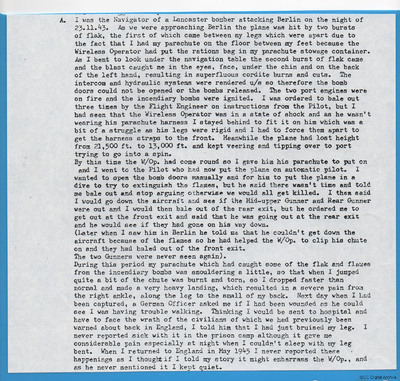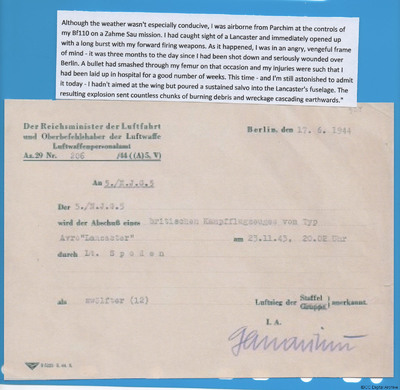The Shooting Down of Allan Smith
Title
The Shooting Down of Allan Smith
Description
The story of Allan's Lancaster after they were damaged by anti-aircraft fire near Berlin. He had a heavy landing and damaged his leg.
The second part of the story is written by a German pilot who was involved in shooting down the damaged Lancaster.
A third item is a note crediting the German pilot with shooting down the Lancaster.
The second part of the story is written by a German pilot who was involved in shooting down the damaged Lancaster.
A third item is a note crediting the German pilot with shooting down the Lancaster.
Creator
Temporal Coverage
Format
Three typewritten sheets
Conforms To
Publisher
Rights
This content is available under a CC BY-NC 4.0 International license (Creative Commons Attribution-NonCommercial 4.0). It has been published ‘as is’ and may contain inaccuracies or culturally inappropriate references that do not necessarily reflect the official policy or position of the University of Lincoln or the International Bomber Command Centre. For more information, visit https://creativecommons.org/licenses/by-nc/4.0/ and https://ibccdigitalarchive.lincoln.ac.uk/omeka/legal.
Contributor
Identifier
BSmithACSmithACv10001, BSmithACSmithACv10002
Transcription
A. I was the Navigator of a Lancaster bomber attacking Berlin on the night of 23.11.43. As we were approaching Berlin the plane was hit by two bursts of flak, the first of which came between my legs which were apart due to the fact that I had my parachute on the floor between my feet because the Wireless Operator had put the rations bag in my parachute stowage container. As I bent to look under the navigation table the second burst of flak came and the blast caught me in the eyes, face, under the chin and on the back of the left hand, resulting in superfluous cordite burns and cuts. The intercom and hydraulic systems were rendered u/s so therefore the bomb doors could not be opened or the bombs released. The two port engines were on fire and the incendiary bombs were ignited. I was ordered to bale out three times by the Flight Engineer on instructions from the Pilot, but I had seen that the Wireless Operator was in a state of shock and as he wasn’t wearing his parachute harness I stayed behind to fit it on him which was a bit of a struggle as his legs were rigid and I had to force them apart to get the harness straps to the front. Meanwhile the plane had lost height from 21,500 ft. to 13,000 ft. and kept veering and tipping over to port trying to go into a spin.
By this time the W/Op. had come round so I gave him his parachute to put on and I went to the Pilot who had now put the plane on automatic pilot. I wanted to open the bomb doors manually and for him to put the plane in a dive to try to extinguish the flames, but he said there wasn’t time and told me bale out and stop arguing otherwise we would all get killed. I then said I would go down the aircraft and see if the Mid-upper Gunner and Rear Gunner were out and I would then bale out of the rear exit, but he ordered me to get out at the front exit and said that he was going out at the rear exit and he would see if they had gone on his way down.
(Later when I saw him in Berlin he told me that he couldn’t get down the aircraft because of the flames so he had helped the W/Op. to clip his chute on and they had baled out of the front exit.
The two Gunners were never seen again).
During this period my parachute which had caught some of the flak and flames from the incendiary bombs was smouldering a little, so that when I jumped quite a bit of the chute was burnt and torn, so I dropped faster than normal and made a very heavy landing, which resulted in a severe pain from the right ankle, along the leg to the small of my back. Next day when I had been captured, a German Officer asked me if I had been wounded as he could see I was having trouble walking. Thinking I would be sent to hospital and have to face the wrath of the civilians of which we had previously been warned about back in England, I told him that I had just bruised my leg. I never reported sick with it in the prison camp although it game me considerable pain especially at night when I couldn’t sleep with my leg bent. When I returned to England in May 1945 I never reported these happenings as I thought if I told my story it might embarrass the W/Op., and as he never mentioned it I kept quiet.
[page break]
Although the weather wasn’t especially conducive, I was airborne from Parchim at the controls of my Bf110 on a Zahme Sau mission. I had caught sight of a Lancaster and immediately opened up with a long burst with my forward firing weapons. As it happened I was in an angry, vengeful frame of mind – it was three months to the day since I had been shot down and seriously wounded over Berlin. A bullet had smashed through my femur on that occasion and my injuries were such that I had been laid up in hospital for a good number of weeks. This time – and I’m still astonished to admit it today – I hadn’t aimed at the wing but poured a sustained salvo into the Lancaster’s fuselage. The resulting explosion sent countless chunks of burning debris and wreckage cascading earthwards.”
[page break]
Der Reichsminister der Luftfahrt und Oberbefehlshaber der Luftwaffe
Luftwaffeempersonalam
[underlined] AS29 Nr. 206/44((A)5.V)
Berlin den 17.6.1944
Am [underlined] 5./N.J.G.5 [/underlined]
Der 5./N.J.G.5 wird der Abeschuss eines britischen Kampfflugseuses von Typ Avro “Lancaster” am 23.11.43. 20.02 Uhr durch Lt. Spoden
Als Ulfter (12) Luftsieg der [deleted] Gruppn. [/deleted] [inserted] Staffel [/inserted] merkamnt.
I.A.
[signature]
By this time the W/Op. had come round so I gave him his parachute to put on and I went to the Pilot who had now put the plane on automatic pilot. I wanted to open the bomb doors manually and for him to put the plane in a dive to try to extinguish the flames, but he said there wasn’t time and told me bale out and stop arguing otherwise we would all get killed. I then said I would go down the aircraft and see if the Mid-upper Gunner and Rear Gunner were out and I would then bale out of the rear exit, but he ordered me to get out at the front exit and said that he was going out at the rear exit and he would see if they had gone on his way down.
(Later when I saw him in Berlin he told me that he couldn’t get down the aircraft because of the flames so he had helped the W/Op. to clip his chute on and they had baled out of the front exit.
The two Gunners were never seen again).
During this period my parachute which had caught some of the flak and flames from the incendiary bombs was smouldering a little, so that when I jumped quite a bit of the chute was burnt and torn, so I dropped faster than normal and made a very heavy landing, which resulted in a severe pain from the right ankle, along the leg to the small of my back. Next day when I had been captured, a German Officer asked me if I had been wounded as he could see I was having trouble walking. Thinking I would be sent to hospital and have to face the wrath of the civilians of which we had previously been warned about back in England, I told him that I had just bruised my leg. I never reported sick with it in the prison camp although it game me considerable pain especially at night when I couldn’t sleep with my leg bent. When I returned to England in May 1945 I never reported these happenings as I thought if I told my story it might embarrass the W/Op., and as he never mentioned it I kept quiet.
[page break]
Although the weather wasn’t especially conducive, I was airborne from Parchim at the controls of my Bf110 on a Zahme Sau mission. I had caught sight of a Lancaster and immediately opened up with a long burst with my forward firing weapons. As it happened I was in an angry, vengeful frame of mind – it was three months to the day since I had been shot down and seriously wounded over Berlin. A bullet had smashed through my femur on that occasion and my injuries were such that I had been laid up in hospital for a good number of weeks. This time – and I’m still astonished to admit it today – I hadn’t aimed at the wing but poured a sustained salvo into the Lancaster’s fuselage. The resulting explosion sent countless chunks of burning debris and wreckage cascading earthwards.”
[page break]
Der Reichsminister der Luftfahrt und Oberbefehlshaber der Luftwaffe
Luftwaffeempersonalam
[underlined] AS29 Nr. 206/44((A)5.V)
Berlin den 17.6.1944
Am [underlined] 5./N.J.G.5 [/underlined]
Der 5./N.J.G.5 wird der Abeschuss eines britischen Kampfflugseuses von Typ Avro “Lancaster” am 23.11.43. 20.02 Uhr durch Lt. Spoden
Als Ulfter (12) Luftsieg der [deleted] Gruppn. [/deleted] [inserted] Staffel [/inserted] merkamnt.
I.A.
[signature]
Collection
Citation
Allan Smith, “The Shooting Down of Allan Smith,” IBCC Digital Archive, accessed July 27, 2024, https://ibccdigitalarchive.lincoln.ac.uk/omeka/collections/document/33372.
Item Relations
This item has no relations.


